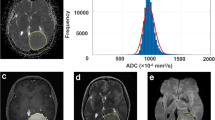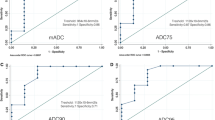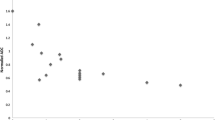Abstract
Purpose
To explore the value of an apparent diffusion coefficient (ADC) histogram in predicting the Ki-67 proliferation index in pituitary macroadenomas.
Material and Methods
This retrospective study analyzed the pathological and imaging data of 102 patients with pathologically confirmed pituitary macroadenoma. Immunohistochemistry staining was used to assess Ki-67 expression in tumor tissue samples, and a high Ki-67 labeling index was defined as 3%. The ADC images of the maximum slice of tumors were selected and the region of interest (ROI) of each slice was delineated using the MaZda software (version 4.7, Technical University of Lodz, Institute of Electronics, Łódź, Poland) and analyzed by ADC histogram. Histogram characteristic parameters were compared between the high Ki-67 group (n = 42) and the low Ki-67 group (n = 60). The important parameters were further analyzed by receiver operating characteristic (ROC).
Results
The mean value, and the 1st, 10th, 50th, 90th, and 99th percentiles were found to be negatively correlated with Ki-67 expression (all P < 0.05), with correlation coefficients of −0.292, −0.352, −0.344, −0.289, −0.253 and −0.267, respectively. The mean ADC and the 1st, 10th, 50th, 90th, and 99th quantiles extracted from the histogram were significantly lower in the high Ki-67 group than in the low Ki-67 group (all P < 0.05). The area under the ROC curve was 0.699–0.720; however, there were no significant between-group differences in variance, skewness and kurtosis (all P > 0.05).
Conclusion
An ADC histogram can be a reliable tool to predict the Ki-67 proliferation status in patients with pituitary macroadenomas.




Similar content being viewed by others
Abbreviations
- ADC:
-
Apparent diffusion coefficient
- AUC:
-
Area under the ROC curve
- CI:
-
Confidence interval
- DWI:
-
Diffusion-weighted imaging
- FOV:
-
Field of view
- ICC:
-
Intra-group correlation coefficient
- MRI:
-
Magnetic resonance imaging
- PA:
-
Pituitary adenoma
- PACS:
-
Picture archiving and communication system
- ROC:
-
Receiver operating characteristic
- ROI:
-
Region of interest
- T1WI:
-
T1-weighted imaging
- T2WI:
-
T2-weighted imaging
References
Conficoni A, Feraco P, Mazzatenta D, Zoli M, Asioli S, Zenesini C, Fabbri VP, Cellerini M, Bacci A. Biomarkers of pituitary macroadenomas aggressive behaviour: a conventional MRI and DWI 3T study. Br J Radiol. 2020;93:20200321.
Go JL, Rajamohan AG. Imaging of the sella and parasellar region. Radiol Clin North Am. 2017;55:83–101.
Bozdağ M, Er A, Ekmekçi S. Association of apparent diffusion coefficient with Ki-67 proliferation index, progesterone-receptor status and various histopathological parameters, and its utility in predicting the high grade in meningiomas. Acta Radiol. 2021;62:401–13.
Wang Y, Bai G, Zhang X, Shan W, Xu L, Chen W. Correlation analysis of apparent diffusion coefficient value and P53 and Ki-67 expression in esophageal squamous cell carcinoma. Magn Reson Imaging. 2020;68:183–9.
Hasanov R, Aydoğan Bİ, Kiremitçi S, Erden E, Güllü S. The prognostic roles of the Ki-67 proliferation index, P53 expression, mitotic index, and radiological tumor invasion in pituitary adenomas. Endocr Pathol. 2019;30:49–55.
Waseda Y, Yoshida S, Takahara T, Kwee TC, Matsuoka Y, Saito K, Kihara K, Fujii Y. Utility of computed diffusion-weighted MRI for predicting aggressiveness of prostate cancer. J Magn Reson Imaging. 2017;46:490–6.
Xiaoai K, Qing Z, Lei H, Junlin Z. Differentiating microcystic meningioma from atypical meningioma using diffusion-weighted imaging. Neuroradiology. 2020;62:601–7.
Tamrazi B, Pekmezci M, Aboian M, Tihan T, Glastonbury CM. Apparent diffusion coefficient and pituitary macroadenomas: pre-operative assessment of tumor atypia. Pituitary. 2017;20:195–200.
Just N. Improving tumour heterogeneity MRI assessment with histograms. Br J Cancer. 2014;111:2205–13.
Xu M, Tang Q, Li M, Liu Y, Li F. An analysis of Ki-67 expression in stage 1 invasive ductal breast carcinoma using apparent diffusion coefficient histograms. Quant Imaging Med Surg. 2021;11:1518–31.
Liang HY, Huang YQ, Yang ZX, Ying-Ding, Zeng MS, Rao SX. Potential of MR histogram analyses for prediction of response to chemotherapy in patients with colorectal hepatic metastases. Eur Radiol. 2016;26:2009–18.
Zhang XN, Bai M, Ma KR, Zhang Y, Song CR, Zhang ZX, Cheng JL. The value of magnetic resonance imaging histograms in the preoperative differential diagnosis of endometrial stromal sarcoma and degenerative hysteromyoma. Front Surg. 2021;8:726067.
DeLong ER, DeLong DM, Clarke-Pearson DL. Comparing the areas under two or more correlated receiver operating characteristic curves: a nonparametric approach. Biometrics. 1988;44:837–45.
Hu XX, Yang ZX, Liang HY, Ding Y, Grimm R, Fu CX, Liu H, Yan X, Ji Y, Zeng MS, Rao SX. Whole-tumor MRI histogram analyses of hepatocellular carcinoma: Correlations with Ki-67 labeling index. J Magn Reson Imaging. 2017;46:383–92.
Ugga L, Cuocolo R, Solari D, Guadagno E, D’Amico A, Somma T, Cappabianca P, Del Basso de Caro ML, Cavallo LM, Brunetti A. Prediction of high proliferative index in pituitary macroadenomas using MRI-based radiomics and machine learning. Neuroradiology. 2019;61:1365–73.
Gerges MM, Rumalla K, Godil SS, Younus I, Elshamy W, Dobri GA, Kacker A, Tabaee A, Anand VK, Schwartz TH. Long-term outcomes after endoscopic endonasal surgery for nonfunctioning pituitary macroadenomas. J Neurosurg. 2020; https://doi.org/10.3171/2019.11.JNS192457. Epub ahead of print.
Xianwang L, Lei H, Hong L, Juan D, Shenglin L, Caiqiang X, Yan H, Junlin Z. Apparent Diffusion Coefficient to Evaluate Adult Intracranial Ependymomas: Relationship to Ki-67 Proliferation Index. J Neuroimaging. 2021;31:132–6.
Kim EJ, Kim SH, Park GE, Kang BJ, Song BJ, Kim YJ, Lee D, Ahn H, Kim I, Son YH, Grimm R. Histogram analysis of apparent diffusion coefficient at 3.0t: Correlation with prognostic factors and subtypes of invasive ductal carcinoma. J Magn Reson Imaging. 2015;42:1666–78.
Ahn SJ, Choi SH, Kim YJ, Kim KG, Sohn CH, Han MH, Chang KH, Min HS. Histogram analysis of apparent diffusion coefficient map of standard and high B-value diffusion MR imaging in head and neck squamous cell carcinoma: a correlation study with histological grade. Acad Radiol. 2012;19:1233–40.
Xue C, Zhang B, Deng J, Liu X, Li S, Zhou J. Differentiating giant cell glioblastoma from classic glioblastoma with diffusion-weighted imaging. World Neurosurg. 2021;146:e473–8.
Meyer HJ, Wienke A, Surov A. ADC values of benign and high grade meningiomas and associations with tumor cellularity and proliferation—A systematic review and meta-analysis. J Neurol Sci. 2020;415:116975.
Zhang YD, Wang Q, Wu CJ, Wang XN, Zhang J, Liu H, Liu XS, Shi HB. The histogram analysis of diffusion-weighted intravoxel incoherent motion (IVIM) imaging for differentiating the gleason grade of prostate cancer. Eur Radiol. 2015;25:994–1004.
Koh DM, Collins DJ, Orton MR. Intravoxel incoherent motion in body diffusion-weighted MRI: reality and challenges. AJR Am J Roentgenol. 2011;196:1351–61.
Gupta P, Dutta P. Landscape of Molecular Events in Pituitary Apoplexy. Front Endocrinol (Lausanne). 2018;9:107.
Tang Q, Li Q, Xie D, Chu K, Liu L, Liao C, Qin Y, Wang Z, Su D. An Apparent Diffusion Coefficient Histogram Method Versus a Traditional 2-Dimensional Measurement Method for Identifying Non-Puerperal Mastitis From Breast Cancer at 3.0 T. J Comput Assist Tomogr. 2018;42:776–83.
Wang W, Cheng J, Zhang Y, Wang C. Use of Apparent Diffusion Coefficient Histogram in Differentiating Between Medulloblastoma and Pilocytic Astrocytoma in Children. Med Sci Monit. 2018;24:6107–12.
Ren JL, Yuan Y, Li XX, Shi YQ, Tao XF. Histogram analysis of apparent diffusion coefficient maps in the prognosis of patients with locally advanced head and neck squamous cell carcinoma: Comparison of different region of interest selection methods. Eur J Radiol. 2018;106:7–13.
Guo Y, Kong QC, Li LQ, Tang WJ, Zhang WL, Ning GY, Xue J, Zhou QW, Liang YY, Wu M, Jiang XQ. Whole Volume Apparent Diffusion Coefficient (ADC) Histogram as a Quantitative Imaging Biomarker to Differentiate Breast Lesions: Correlation with the Ki-67 Proliferation Index. Biomed Res Int. 2021;2021:4970265.
Funding
This work was supported by the National Natural Science Foundation of China under project name Imaging Quantitative Evaluation of Radiotherapy Efficacy of Glioma Based on Spectral CT [grant number 81772006].
Author information
Authors and Affiliations
Contributions
Caiqiang Xue and Suwei Liu contributed equally to this work.
Corresponding author
Ethics declarations
Conflict of interest
C. Xue, S. Liu, J. Deng, X. Liu, S. Li, P. Zhang and J. Zhou declare that they have no competing interests.
Ethical standards
For this article no studies with human participants or animals were performed by any of the authors. All studies performed were in accordance with the ethical standards indicated in each case.
Rights and permissions
About this article
Cite this article
Xue, C., Liu, S., Deng, J. et al. Apparent Diffusion Coefficient Histogram Analysis for the Preoperative Evaluation of Ki-67 Expression in Pituitary Macroadenoma. Clin Neuroradiol 32, 269–276 (2022). https://doi.org/10.1007/s00062-021-01134-x
Received:
Accepted:
Published:
Issue Date:
DOI: https://doi.org/10.1007/s00062-021-01134-x




